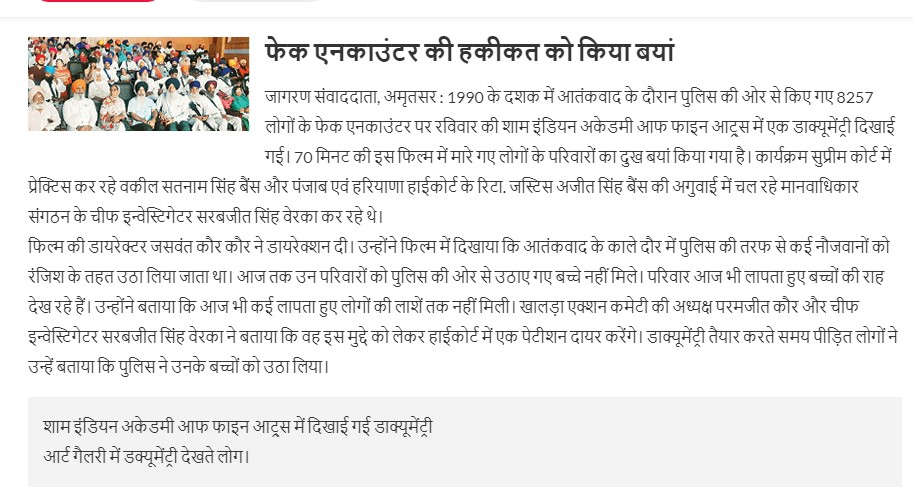On 29 June 1991, Gurmeet Singh was nearly 2 years old, when he last saw his father. His parents—Rattan Singh and Jaswinder Kaur—had gone to attend an ardaas (prayer service) for Gurmeet’s paternal uncle. At 11am, Punjab police raided the gathering. Rattan Singh was among those who were picked up. “He was taken to a police station in Gurdaspur and tortured,” says Gurmeet, now 30. He came to know of this years later from his grandfather, Varayam Singh, who raised him and his younger sister.
By the time the local MLA and panchayat members reached Talwandi in Gurdaspur the next morning to demand the men be released, Rattan Singh had been “killed in an encounter”, and cremated. They returned with his ashes.
From the early 1980s till 1995, Punjab was in the grip of militancy, as a political demand for autonomy developed into a separatist movement. Between bombings and bus-burning, people recall times where men would walk through the districts of Tarn Taran, Gurdaspur and Amritsar, armed and fearless. Many left the state. The early 1990s saw the bloodiest phase as the state launched counter-insurgency operations, arming the state police with laws such as The Armed Forces (Punjab and Chandigarh) Special Powers Act (1983) and The Punjab Disturbed Areas Act (1983). They would pick up or shoot men on mere suspicion, and often their families as well.
A Human Rights Watch report conducted during that period revealed that torture in police custody included “electric shock, applied to the victim’s genitals, head, ears and legs; prolonged beatings with canes and leather straps; tying the victim’s hands behind the back and suspending him or her from the ceiling by the arms.”
At the age of 10, Gurmeet pieced together information from local panchayat meetings and things he was told. This was how he came to understand why his mother had remarried, abandoning both siblings. “Aise mujhe pata chala ki police ne brutality ki (That’s how I learnt of police brutality),” says the daily-wage worker, who earns close to Rs. 300 per day. As we speak, his voice trails after every sentence.“Humari zindagi narak thi (our lives were hell).”
Varayam, too, was routinely detained until 1997. The children would spend hours at a neighbour’s home, unsure whether their grandfather would return. With an education cut short—Gurmeet studied till class 8 at the Dhan Mata Gujri Ji Trust “where children of martyrs were sent”—he grew up in the shadow of violence, silence and a persistent terror. “Main kisi se nahi baat kar saka. Aap ko toh pata hai ki Sarkar kuch bhi kar sakti hai, sab unhi ke haath mein hai (“I could never speak to anyone about this. You know the state can do anything, everything is in their hands.”)
Nearly three decades later, Gurmeet may be looking at a glimmer of hope. On 20 December last year, the non-profit group Punjab Documentation and Advocacy Project (PDAP) filed a writ in the Punjab and Haryana high court, detailing the “disappearance” and mass cremations of more than 8,000 men by the police between 1984-95, across 1,600 villages in 14 of the state’s 22 districts. Among this number, which hides the trauma of broken families and psychological stress, is the “extrajudicial killing” of Gurmeet’s father, Rattan Singh.
As farmers gather today at the borders of Delhi, demanding a repeal of three new laws they fear will put corporate interests before theirs, a counter-narrative has emerged to discredit the protests. It harks back to this tumultuous phase in Punjab’s history, alleging links between farmer groups and the secessionist movement for Khalistan, ignoring nuance and the barely healed lesions of a decade-long conflict.
“Kisanon ka Khalistan se kya lena dena? Kisan hai toh jahan hai (What have farmers got to do with Khalistan? The world lives on the toil of farmers)” says Jaspal Singh, a 50 year old farmer from Gurdaspur. His younger brother Rashpal, he says, was killed and cremated by the police in 1992. There was no warrant, no trial and no due process. Jaspal has remained silent for over 25 years, but now his brother’s name finds mention in the PDAP petition.
In 2008, the PDAP started a fresh investigation into the human right abuses during the conflict. Over 10 years, it filed queries under the right to information Act, studying 1,400 police FIRs and decades-old records of cremation grounds, analysing archived newspapers and recording testimonies of eyewitnesses and the relatives of those who had disappeared.
“The investigations and records presented to the court show that the Punjab police and security forces would abduct, kill and secretly cremate bodies. Instead of cremating one body at a time, the police often cremated several together in a single pyre and in some cases, up to 18 bodies were cremated in a single day from just a single incident,” says Satnam Singh Bains, a barrister and convener of the PDAP.
The petition includes a call to establish a “Missing Persons Commission” on the lines of the National Commission on the Disappearance of Persons in Argentina. “…even the Geneva Convention provides that during times of war or inter-country conflict bodies of enemy combatants are to be identified, treated with respect and not defiled, yet these victims were citizens of India, who were accorded less rights than a foreign enemy combatant,” it says.
History of blood and ashes
In 2017, the PDAP organised a People’s Tribunal in Amritsar. Over two days, a composite panel of retired judiciary members, prominent activists and academics from across India heard testimonies of the forgotten survivors whose loved ones had ‘disappeared’. The audience was a sea of bodies—nearly everyone either wiping tears or with fixed gazes, holding frayed photographs and old paper clippings—memories and scraps of news about the dead. For many of these 700 families, this was the first time they told their stories.
The cruel irony of human rights in Punjab was that one of the first to raise this question during the 1990s was also among the last of the victims of state excesses: Jaswant Singh Khalra. A human rights activist, he uncovered disappearances, killings and secret cremations, drawing attention globally to the issue.
“Thousands of mothers await their sons. Even though some may know that the oppressor has not spared their sons’ lives on this earth,” said Khalra in June 1995 in the Canadian Parliament. “But a mother’s heart is such that even if she sees her son’s dead body, she does not accept that her son has left her. So the mothers who have not even seen their children’s dead bodies, they were asking us, at least find out: is our son alive or not?”
Punjab witnessed unprecedented violence between 1978 and the early 1990s. In 1966, the then Prime Minister Indira Gandhi ceded to a demand from Sikhs for their own state and created a separate Punjab state along linguistic lines, separating the Hindi and Haryanvi-speaking parts from East Punjab state (as the part of Punjab province in India after Partition was known), and incorporating other Punjabi-speaking areas. A sense of discrimination and of being a minority persisted, and in 1973, the Shiromani Akali Dal made a list of demands, in its Anandpur Sahib Resolution, for “creation of such an environment where Sikh sentiment can find its full expression”.
Fall outs of the Green Revolution, the Union government’s interventions and an increased communalisation of politics led to a struggle for an independent Sikh state of Khalistan during the 1980s. Operation Blue Star, when the military launched an operation against militants in the Golden Temple, the subsequent assassination of Indira Gandhi by her Sikh bodyguards, and the ensuing violence in Delhi in which more than 3,000 Sikhs were killed, fanned the embers of sectarian violence. In 1988, the 59th Amendment to the Constitution suspended fundamental rights in the state. By 1995, the resistance of the rural Sikh population to both militancy and counterinsurgency put an end to Punjab’s most tumultuous phase after independence.
By then, according to a report in The Tribune, over 21,000 people had been killed in Punjab—over 8,000 were categorised as militants, 11,696 were civilians, and 1,746 were security force personnel (among them, 1,415 Punjab police officials). The militants would abduct people, threaten or kill judges, politicians, media professionals and police officers and their families. In this context, the state was given a free hand. The first DGP sent in at the time, Julio Ribeiro implemented the famed “bullet for bullet” policy and then under Punjab police DGP KPS Gill until 1995, Punjab saw a spate of “fake encounters”, custodial deaths and mass cremations.
“They virtually converted this into an ideological argument: Since things are bad, anything the police does should be accepted,” says Human Rights lawyer and senior advocate Nitya Ramakrishnan, who formed the Committee for Information and Initiative on Punjab in the 1980s along with four others. “The human rights violations in Punjab were horrible. If you reach a place where there is no difference between you and the extremists in your violence, then what is it that we are preserving the state from?”
In the 1990s, Khalra was the director of a cooperative bank in Amritsar when two of his colleagues disappeared. “It all began when he committed himself to helping these families find out what had happened. Sure enough they found the two had been picked up by the police, killed and cremated. The families were not even handed over their remains,” says his wife Paramjit Kaur Khalra.
What started as a quest to find his friends led to the discovery of a number of “unidentified” pyres. The first registers documenting these listed over 300 cremations from the Durgiana Mandir ground in 1992. He obtained similar records of two other crematoria in Amritsar district, and in 1993, filed a PIL (public interest litigation) in the Chandigarh high court with his findings. “He would receive threats from the police like, ‘we have disappeared 25,000 people, we have no problem if that’s 25,001’,” says Paramjit.
Early on 6 September 1995, Jaswant asked a bewildered Paramjit to promise that she would be able to raise the children alone. “I didn’t understand it, but he obviously knew something was about to happen,” she recalls. Later that morning, after their two children left for school and Paramjit set out for work at the University library in Amritsar, the Punjab police surrounded the colony. Before she could even begin the day’s tasks and just after she had marked attendance, Paramjit got a frantic call from one of her neighbours: The police had taken her husband.
“At this point I had two options, to keep quiet and continue like nothing had happened, or to actually do something about it,” says Paramjit. She filed a habeas corpus petition in the High Court and spent the next 16 years of her life getting justice for her husband, whom she never saw again.
It was only 3 years after the case began that they found a witness.“The gunman of the officer who took Jaswant confessed to the CBI that Jaswant had been eliminated and burnt,” she says.
“It is horrifying to visualise that dead bodies of large number of persons allegedly thousands could be cremated by the police unceremoniously with a label “unidentified,” the Court said in its order in 1996. It also directed the Director, Central Bureau of Investigation (CBI) to appoint a high powered team to investigate the matter, limited to the cremation grounds in Amritsar. Simultaneously, the NHRC awarded monetary relief of upto Rs. 2.5 lakhs to the next of kin of the deceased, however it did not investigate which officers were responsible for these killings.
In 2007, the Punjab and Haryana High Court gave life terms to five police officers, and acquitted a sixth in the case. In November 2011, the Supreme Court upheld the convictions and sentences.
Paramjit’s children were 12 or 13 at the time and found out about their father’s death as teachers and children talked about it in school. She has spent nearly two decades doggedly pursuing justice and has since committed herself to find ways to compensate victim families, to ensure justice, no matter how delayed. In 2019, she contested the Lok Sabha elections from the Khadoor Sahib constituency and came in second. “Neither can we forget this pain, neither can we bare this pain, neither can we forgive this pain,” she says.
Over the years, the position of the Punjab police has been consistent: Its officers were not trained to fight “internationally sponsored terror” and “tactics had to be deployed” to eliminate militancy and “bring Punjab back from the brink”. A CBI court has convicted a number of officers for illegal cremations, judgements that have upset Punjab police, which has argued that policemen “who worked under a reign of fear and terror” should be treated with leniency. The Punjab police DGP and state chief secretary did not respond to Lounge’s requests for interviews over phone, text and email.
“Human rights are for the benefit of the system too, and the collective. To ensure that you don’t go after wrong people,” says Ramakrishnan. “If you summarily kill off a bunch of people and call them militants, then are you really freeing the state of terror? It’s no one’s case that lethal force cannot be used in private defence, but the law is the law—there has to be some accountability.”
For 25 years, Jaspal Singh has been waiting for just that—accountability. The police, he says, picked up the fourth of 6 brothers on 4 June 1992. Rashpal Singh was in his 20s; a singer and composer, “much beloved in their village”. “Bohot yaad aati hai, tamboora le ke raat ko gaana gata tha, toh gaon ke log bolte the raunak laga ditti (we think about him constantly, when he would sing at night everyone would say he added life to the village).”
Once they received word from someone Jaspal says was a “god-fearing police officer”, the bothers co-ordinated efforts along with local leaders to bring him home. They found their way to Chandan di Madi, a cremation ground in Gurdaspur. “Two men were killed and cremated that day, one was our brother and the other man remained unclaimed. We brought home the remains of two brothers that day,” he says.
Missing stories of women
If “accountability” has been missing from the Punjab story of the 1990s, also absent is the story of women during the conflict. As Mallika Kaur, a lawyer and writer who focuses on gender and minority issues in the US and south Asia points out, “Within the marginalised Punjab conflict, as is most often the case, gender dynamics have been further marginalized. Or at best described in a very unidimensional and politically expedient way: the turbaned Sikh man as angry and prone to violence, the Sikh woman as the hapless victim.” She adds, “These descriptions caricature human lives and aspirations. And about women’s stories, there are embarrassingly few accounts, especially in English. For Punjab’s conflict narrative, where the aftermath of 1984 ravaged the countryside, women’s bodies are accepted as hidden, silent, receptacles.”
Amreek Kaur, 55, and her husband, Jasbir Singh, were arrested from the same gathering Gurmeet’s father had attended. As we speak, her voice is steady, as if the memory has almost hardened her over the years. “They took me to a separate place and beat me so hard, the SHO ripped my hair so brutally, it still doesn’t grow in that particular spot, to this day.” She then describes what broke her even more than the physical abuse. “They were celebrating and distributing sweets to us in jail, they even handed me some. I was only told later that it was because they had killed those men—one of them being my husband.”
Amreek was finally released and asked to go home with her father and local leaders through the village, instructed not to use the main road by the police. In between, she slips in something, almost in passing. “It was horrible, unhone itni gaaliyan di, andar humein kapde bhi nahi pehnne diye (they hurled such abuse, they didn’t even let us wear our clothes inside).” Was there a lady constable, I ask. Amreek says there was not.
“There are countless stories of rape and sexual and physical violence against women during the violence, “says Mallika. “But these stories have not necessarily been heard with the nuance and sensitivity they deserve. Through the conflict, women persevered as breadwinners after men were taken or killed: they tilled lands, ran businesses; they have been fearless litigants and organisers for justice…they have been the grandmotherly and motherly embrace that added a semblance of normalcy for kids growing up with unspeakable trauma; they have been the storytellers and the repository of our recent history.” Many families of those who “disappeared”, where bodies were cremated as “unclaimed or unidentified”, have not been given death certificates.
The PDAP has documented some of these struggles too. Even as mothers take on full-time jobs to raise their children—some at beauty parlours, others in the fields or as dailywage labourers and teachers, they have had trouble accessing succession and inheritance rights. This is because as families of the ‘disappeared’, where bodies are burned as “unclaimed or unidentified”—many have not been given death certificates.
Amreek raised all 3 of her children with some help from her family. Still, like Gurmeet, her son Vikramjit was young at the time, and the death of his father had long term implications for his professional life. “I tried to join the army in 2003. I cleared all the stages, but when it was time for the inquiry, they wrote that I am a terrorist’s son. That was the end of my dreams.” Only 4 years old at the time, Vikramjit had to cut short his education and help support the family along with his older brother. He started as a dailywage labourer at the age of 8 and would earn between Rs.50-100 per day.
“If we had our parents, we would have at least had some guidance,” says Gurmeet. “But what kind of future do you expect children like us to have? We have had to give up our education, we can’t get good jobs but we have to fend for ourselves, and constantly live in fear. This is all we are.” His voice trails.
Too long a wait
Even as the PDAP’s new petition ignites a fresh hope for justice beyond Amritsar, for some who chose the legal system to hold the state to account have not lived long enough to see it through. For nearly 18 years, the question of sanction to prosecute police officers lay gathering dust with the courts. Eventually, a few months after the Supreme Court dismissed it in 2016, 100 year-old Chaman Lal, who had been fighting a case for his son Gulshan Kumar’s disappearance, died. He was the sole eyewitness in the case.
“There was also the case of a woman who was travelling with her son Balwinder, who was taken by the police and killed—they were looking of a different Balwinder and admitted as much to his mother at her home, where she was asked to make them tea while they told her,” says Bains of the PDAP. “She was pursuing his case, and had been for decades. She died earlier this year.”
Still, after all these years, families young and old are hopeful. For years, Bakshish Singh could not hang the photo of his disappeared son at home—it had the date of his death written neatly on the side—out of fear that he may be picked up or threatened. Eventually, over time, he put it up. His grand daughter was 10 when she first asked him who this man was and what happened to him. The 84 year old has lived out his days now, he says. “But we all have rights don’t we? No court of law says he was a militant. I have lived an honest life. Do I not deserve some dignity?”
While the opinion among the state authorities is that the diaspora has long tried to revive a conversation long dead after all these years, the question that Bakshish Singh asks continues to loom heavy on the forgotten families of Punjab’s ‘disappeared’.
Read the original story here.
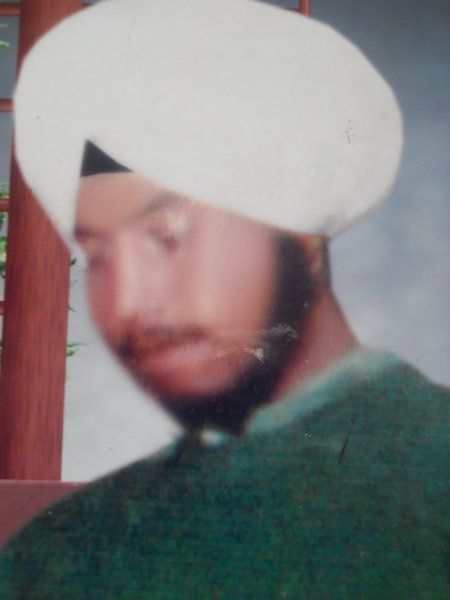

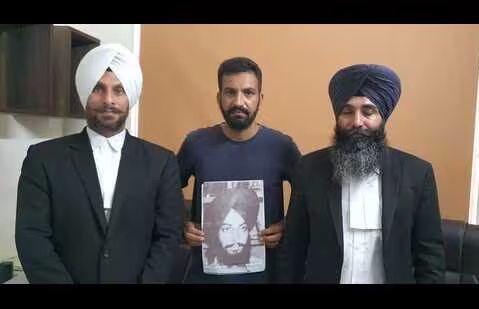

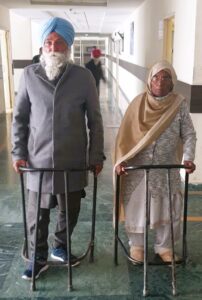


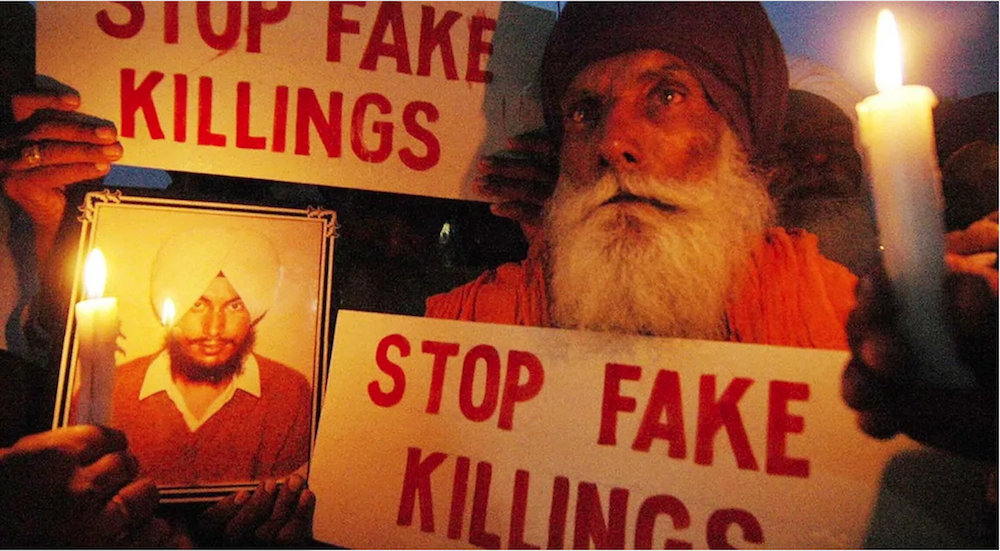
 Punjab’s Ajit Newspaper, 8th July, 2019
Punjab’s Ajit Newspaper, 8th July, 2019